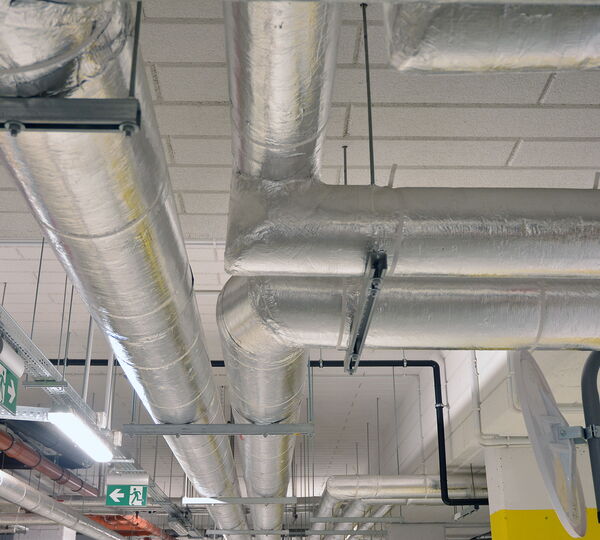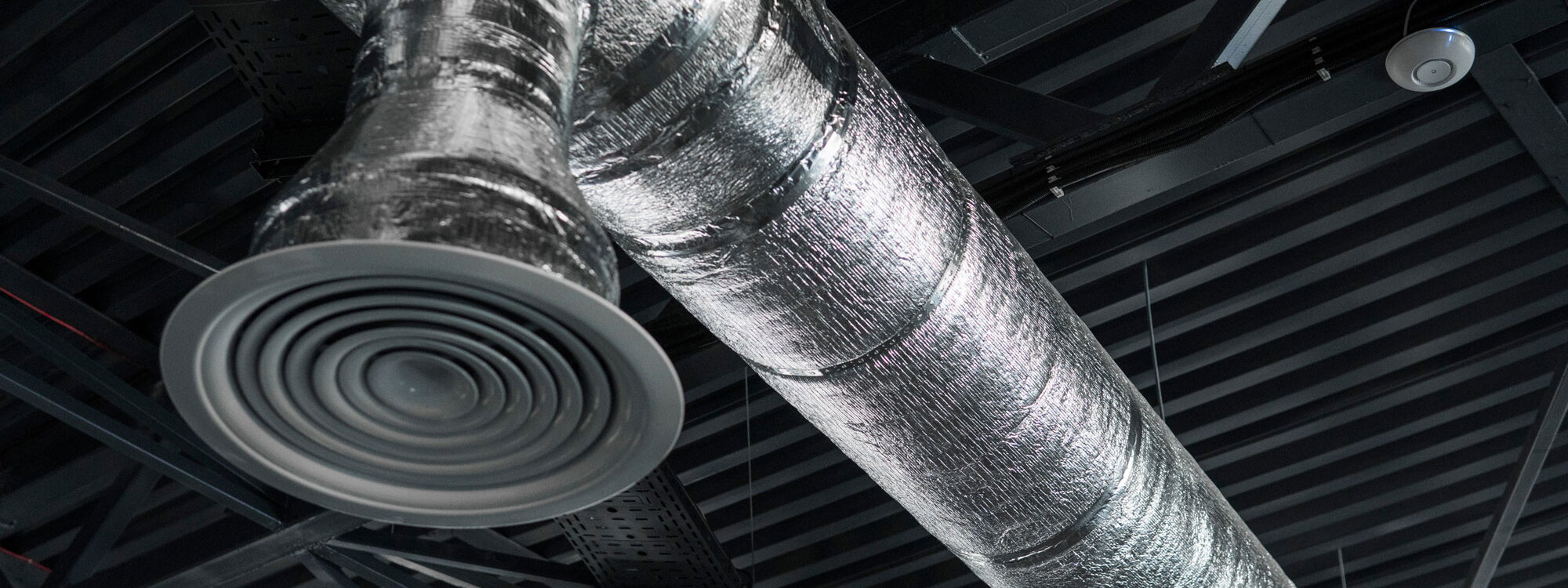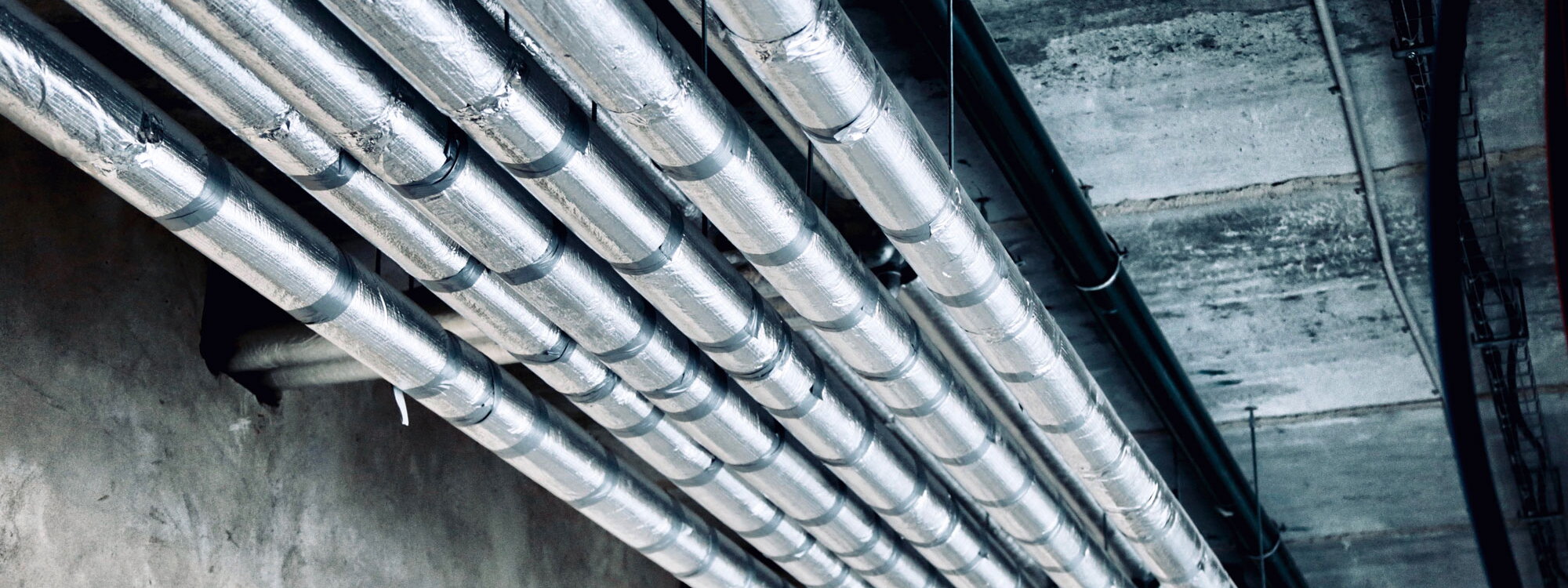Stop Breakout and HVAC or Piping Related Noise
Acoustical wraps function by combining two essential sound control principles: mass and absorption. The outer layer of the wrap is typically constructed from flexible mass-loaded vinyl (MLV), a dense material designed to block airborne sound from escaping the surface of pipes or ducts. This layer adds weight and stiffness to the wrap, minimizing the transmission of mid- and high-frequency noise that would otherwise travel easily through thin-walled ductwork or piping. To protect the MLV and enhance its performance, it is often laminated with a reinforced foil-facing.
This foil layer not only acts as a moisture-resistant barrier but also offers thermal benefits, helping regulate temperature and condensation on mechanical surfaces. The foil is also cleanable and provides a rugged outer surface suitable for a range of environments.
To boost performance, many acoustical wraps also include a quilted fiberglass absorber lining. This inner layer serves multiple roles—it absorbs reflected noise within the wrap’s cavity, minimizes the resonance of the barrier, and acts as a vibration decoupler. This decoupling is critical for reducing structure-borne noise, especially in systems where pipes or ducts carry mechanical vibrations from fans, motors, or flowing fluids.
The result is a product capable of delivering broad-spectrum acoustic control, especially in demanding applications where low-frequency vibration and airborne noise are present simultaneously. This dual-layer composition is particularly effective against common sources of mechanical noise such as fan whine, air turbulence, high-velocity air movement, and water hammer effects.
Installation is straightforward and adaptable to both retrofit and new systems. The wrap is measured and cut to fit, then wrapped snugly around the pipe or duct. It is typically secured using metal bands, high-strength adhesives, or mechanical fasteners, depending on the system configuration. For maximum performance, overlapping seams should be sealed using acoustical tape or foil-faced sealing tape, creating a continuous, gap-free sound barrier.
Whether used on circular duct runs, rectangular chases, or irregularly shaped plumbing lines, acoustical wraps offer flexible installation without requiring extensive modifications to existing infrastructure.
Key Features and Benefits
Effective Noise Reduction: Acoustical wraps can reduce noise levels by 5 to 15 dB depending on the application, material thickness, and installation quality. When combined with quilted fiberglass, the wrap’s performance is significantly enhanced.
Thermal and Acoustic Control: The foil-faced exterior not only blocks sound but also provides thermal insulation, helping to manage condensation and improve energy efficiency.
Flexible and Versatile: The material conforms easily to curved and irregular surfaces, making it ideal for both round and rectangular pipes and ducts. It’s well-suited for retrofitting existing systems or new construction.
Indoor and Outdoor Rated: Weather-resistant facings and reinforced materials allow the wrap to be used in both indoor mechanical rooms and exposed outdoor environments.
Durable Construction: The composite structure is tear-resistant, puncture-resistant, and built to withstand temperature fluctuations, moisture, and contact over time.
Quick and Easy Installation: Lightweight and flexible, acoustical wraps can be installed with minimal disruption to existing systems using standard mechanical fastening methods.

Frequently Asked Questions
A: Use it any time you need to reduce noise generated by mechanical systems—especially in noise-sensitive environments like offices, hotels, hospitals, or apartments. If your building experiences complaints about air handler noise, drainpipe gurgling, or HVAC rumble, pipe and duct wrap can be an effective, non-invasive solution.
A: The wrap is cut to length, wrapped around the pipe or duct, and secured using bands, mechanical fasteners, or high-temperature adhesives. Overlapping seams are sealed with matching foil-faced tape or acoustical sealant to ensure continuity. Installation can typically be done without dismantling the existing system.
A: Yes. Wraps with reinforced foil or all-weather jackets are rated for outdoor use. They resist UV exposure, moisture, and temperature extremes, making them suitable for rooftop ductwork, external plumbing runs, and outdoor mechanical units.
A: Acoustical floor underlayments are often rated with an IIC (Impact Insulation Class) score, which quantifies how well a floor/ceiling assembly reduces impact sound transmission. A good underlayment can improve IIC scores by 10 to 25 points or more. Practically speaking, this equates to a noticeable reduction in footstep noise, dropped item echoes, and general floor vibrations. The level of improvement depends on a variety of factors including the existing floor assembly, the quality of the underlayment, and how it’s installed. It’s important to ensure underlayments are installed properly—gaps, overlaps, or using incompatible adhesives can compromise performance.
A: Yes. When paired with a quilted fiberglass absorber or similar decoupling layer, acoustical wraps help to dampen vibrations that contribute to structure-borne noise. This combination is especially effective for metallic pipes and ducts.
A: Typical noise reduction ranges from 5 to 15 dB depending on wrap thickness, duct or pipe material, and installation quality. Higher reductions can be achieved in systems using both barrier and absorber layers.
A: No. Since the wrap is applied externally, it does not interfere with the interior flow of air or water. In fact, the thermal properties of the wrap can help prevent heat loss or condensation in some systems.


